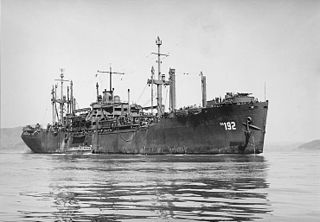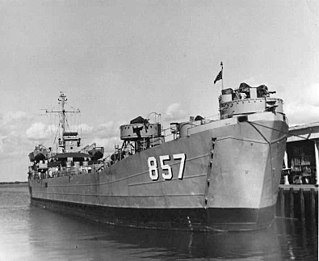
USS Cassin (DD-372) was a Mahan-class destroyer in the United States Navy before and during World War II. She was the second ship named for Stephen Cassin, an officer in the United States Navy.

USS Pakana (AT–108) was an Abnaki-class fleet ocean tug. It was named after the Pakana, a Native American tribe of Texas. This ship saw service in the Pacific theater of World War II, and was later transferred to the United States Bureau of Mines for use in Alaska before being deliberately sunk in 1975.

USS Mender was a Gypsy-class salvage lifting vessel of the United States Navy. Originally designated LSM‑550, she was reclassified on 24 April 1945, and was laid down on 25 August 1945 by Brown Shipbuilding Corporation, Houston, Texas. Launched on 7 December 1945; and commissioned on 8 March 1946.

USS Rutland (APA-192) was a Haskell-class attack transport built and used by the US Navy in World War II. She was a Victory ship design, VC2-S-AP5. She was named after Rutland County, Vermont, USA.

USS Logan (APA-196) was a Haskell-class attack transport of the United States Navy, named for counties in Colorado, Illinois, Kansas, Kentucky, Ohio, Oklahoma, Nebraska, North Dakota, and West Virginia. The Haskell-class design, United States Maritime Commission standard type VC2-S-AP5, is a sub type of the World War II Victory ship design.

USS Barrow (APA-61) was a Gilliam class attack transport serving in the United States Navy from 1944 to 1946. She was scuttled in 1948.

USS Orange County (LST–1068) was an LST-542-class tank landing ship built for the United States Navy during World War II. Unlike many of her class, which received only numbers and were disposed of after World War II, she survived long enough to be named. On 1 July 1955, all LSTs still in commission were named for US counties or parishes; LST-1068 was given the name Orange County, for counties in the states of California, Florida, Indiana, New York, North Carolina, Texas, Vermont, and Virginia, she was the only US Naval vessel to bear the name.
USS LST-823 was an LST-542-class tank landing ship in the United States Navy. Like many of her class, she was not named and is properly referred to by her hull designation.

USS King County (LST-857) was an LST-542-class tank landing ship built for the United States Navy during World War II. Named after counties in Texas and Washington, she was the only U.S. Naval vessel to bear the name.

USS Pitkin County (LST-1082) was an LST-542-class tank landing ship built for the United States Navy during World War II. Named after Pitkin County, Colorado, she was the only U.S. Naval Vessel to bear the name.

USS Lipan (AT-85) was a Navajo-class fleet tug constructed for the United States Navy during World War II. Her purpose was to aid ships, usually by towing, on the high seas or in combat or post-combat areas, plus "other duties as assigned." She served in the Pacific Ocean during World War II and the Korean War. She was awarded two battle stars for World War II and four battle stars for the Korean War.
USS LST-888 was an LST-542-class tank landing ship built for the United States Navy during World War II. Late in her career she was renamed Lee County (LST-888) – after counties in twelve Southern and Midwestern states, the only U.S. Naval vessel to bear that name – but saw no active service under that name.
USS Lyon County (LST-904) was an LST-542-class tank landing ship built for the United States Navy during World War II. Named after counties in Iowa, Kansas, Kentucky, Minnesota, and Nevada, she was the only U.S. Naval vessel to bear the name.

USS Shackle (ARS-9) was a Diver-class rescue and salvage ship commissioned by the U.S. Navy for service in World War II. She was responsible for coming to the aid of stricken vessels.
USS Vent (ARS-29) was a Diver-class rescue and salvage ship commissioned by the U.S. Navy during World War II. Her task was to come to the aid of stricken vessels.
USS Clamp (ARS-33) was an Diver-class rescue and salvage ship acquired by the U.S. Navy during World War II. Her task was to come to the aid of stricken vessels.
USS Gear (ARS-34) was a Diver-class rescue and salvage ship acquired by the U.S. Navy during World War II. Her task was to come to the aid of stricken vessels.
USS LST-766 was an LST-542-class Landing Ship, Tank in the United States Navy during World War II that took part in the amphibious landings during the war in the Far East.

USS Moctobi (ATF-105) was an Abnaki-class of fleet ocean tug. She served in World War II, Vietnam, and Korea, the last two of which she received battle stars. She was scrapped in 2012.

USS Jicarilla (ATF-104) was Abnaki-class tugboat during the World War II. The ship was later sold to Colombia as ARC Sebastián De Belalcázar (RM-73). Her namesake is a group of the Apache tribe found in the southwestern United States.












